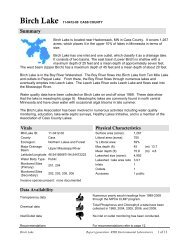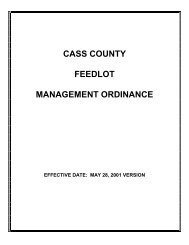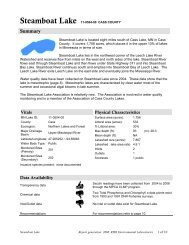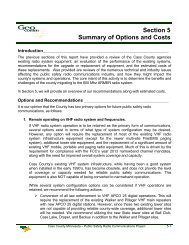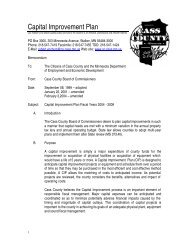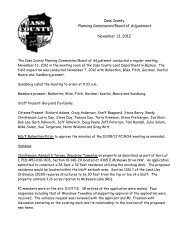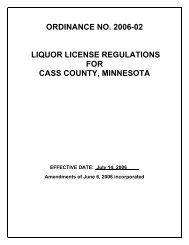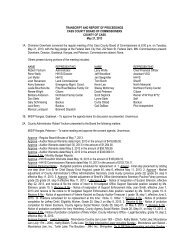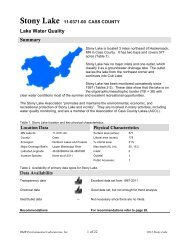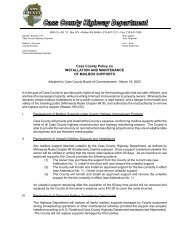Section 3 ARMER/System Technology Review and Industry Activities
Section 3 ARMER/System Technology Review and Industry Activities
Section 3 ARMER/System Technology Review and Industry Activities
- No tags were found...
You also want an ePaper? Increase the reach of your titles
YUMPU automatically turns print PDFs into web optimized ePapers that Google loves.
<strong>Section</strong> 3<strong>ARMER</strong>/<strong>System</strong> <strong>Technology</strong><strong>Review</strong> <strong>and</strong> <strong>Industry</strong> <strong>Activities</strong>This section of the report is provided to help educated the customer on a number of publicsafety radio technology <strong>and</strong> regulatory issues that will have an impact on near-term radiosystem requirements, as well as provide a foundation of underst<strong>and</strong>ing upon which some of ourrecommendations <strong>and</strong>/or options will be based.Of the technologies discussed in this section, very little is currently incorporated into the CassCounty radio system, however both the main North <strong>and</strong> South repeaters incorporate a form of“Multicast”, since multiple sites are utilized. Other technologies such as P25 Digital Modulation,<strong>and</strong> Simulcast or Multicast Transmission are incorporated into the State of Minnesota <strong>ARMER</strong>800 Mhz radio network, <strong>and</strong> are highly desirable.This section is also intended to provide an overview of the State of MN <strong>ARMER</strong> radio network,along with some of the technology “options” that will need to be considered by the County if theydecide to move forward with <strong>ARMER</strong> implementation.The mission of Public Safety agencies is to protect the lives <strong>and</strong> property of citizens. PublicSafety radio systems present a unique set of performance requirements, <strong>and</strong> technology thatmay be perfectly suited for cellular or point-to-point communications will often fail to meet theunique needs of public safety agencies. Public Safety communications systems have thefollowing general characteristics:1. Relatively large number of users on a limited number of channels2. Wide-area communications requiring multiple transmit/receive sites3. Communications with groups of users distributed over a wide area4. Relatively brief message exchanges5. Centralized dispatch operations6. Transmissions from one to many users (talkgroups)All of these characteristics contribute to define a mission critical communications system thatdelivers on the Public Safety promise to protect the lives <strong>and</strong> property of citizens. In view ofthese characteristics, the following have emerged as the two essential <strong>and</strong> inter-relatedcriteria for evaluating the effectiveness of Public Safety communications systems:Coverage - Public Safety users must often be able to conduct communications withmembers of their group throughout their entire service area. This coverage must becomprehensive, with minimal “dead spots” or interference areas. It must be reliable, <strong>and</strong> notchange with time, distance, or weather. It must have depth, with the ability to reach intovehicles, buildings, <strong>and</strong> low-lying terrain.Cass County, Minnesota Public Safety Radio Communications Study – 2008 3-1
Simulcast transmission: This is the newest <strong>and</strong> most advanced method of transmittingcoverage system design. With a Simulcast system, all transmitters for a given radio channel (or“Talk Group” in a Trunked system) are turned on at the same time <strong>and</strong> essentially “blanket” theentire county area with coverage. This method of operation provides the best solution for acouple of reasons: No manual intervention is required by either dispatch or the mobile radio user; as alltransmitters for a particular radio channel are activated simultaneously (hence theSimulcast terminology), a “blanket” of coverage is provided throughout the service area. Increased radio signal strength in overlap areas due to “additive” characteristics of radiosignals. There will be many areas where the transmitted signals from the various towersites overlap; in these areas the two signals combine in-phase <strong>and</strong> create a muchstronger signal than would be received from a single tower site.Simulcast is the simultaneous broadcast of radio signals on the same channel from all sites.In a simulcast system all channels are present at all sites. Simulcast ensures consistentcoverage throughout the service area with the most efficient use of frequencies.The use of Simulcast technology is truly the simplest method of operation for the users of theradio system. It is also very complex from a technology perspective. This is due primarily to theneed for all of the transmitters in the system to be exactly in-phase <strong>and</strong> therefore requiresspecial synchronization equipment at each transmitter site.In earlier Simulcast systems, elaborate synchronization <strong>and</strong> timing schemes were employed tokeep all transmitters “aligned” <strong>and</strong> these systems required a higher than normal amount ofmaintenance to ensure optimum performance. In recent years, the introduction of GPS timingsystems has greatly improved the performance of Simulcast systems <strong>and</strong> they are nowgenerally no more maintenance-intensive than st<strong>and</strong>ard radio systems.Simulcast systems also may require more tower sites than other system options, as there is acritical engineering factor affecting the line-of-sight distance between the sites. Simulcasttransmitter sites may be no more than 7 miles (VHF) to 18 miles (800 Mhz) between tower sitesdue to potential problems with the overlap zones.A Simulcast system is also much more expensive than a st<strong>and</strong>ard radio system due to the needfor a higher-quality level of equipment <strong>and</strong> greater complexity. Many commercial utility <strong>and</strong>public safety organizations either have or are in the process of implementing Simulcasttechnology.Shown on the following pages are some diagrams to demonstrate the differences between thetypes of systems.Cass County, Minnesota Public Safety Radio Communications Study – 2008 3-8
The diagram below shows how a 2-site Simulcast system provides exp<strong>and</strong>ed coverage for fieldunits, without the unit needing to change channels or frequency to stay in range of both towersites. Both tower sites transmit <strong>and</strong> receive on the same set of frequencies. The portable radiocan move between tower sites without concern about selecting the “proper” tower site.Overlap AreaRptr Channel 1,Tower #1Rptr Channel1, Tower #2Note that the above diagram shows only a single frequency at each tower site. This would betypical for a VHF radio system, though the simulcast technology can be used for VHF, UHF, or800 Mhz radio systems.The next diagram shows the same situation, but for a multi-channel trunked radio system. Eachtower site has multiple channels available for the radio users to select.Overlap AreaRptr Channels 1 – 5,Tower #1Rptr Channels 1 – 5,Tower #2f 1 f 2 f 3 f 4 f 5f 1 f 2 f 3 f 4 f 5Cass County, Minnesota Public Safety Radio Communications Study – 2008 3-9
Shown below is a simple comparison to show how Simulcast technology can improve in-buildingcoverage. With the signals being transmitted from multiple locations (towers), there existmultiple directions from which the signals can enter <strong>and</strong> exit the building structure.Multicast <strong>System</strong>Simulcast <strong>System</strong>Field units can only communicatewith one site at a time. Resultsin less reliable coverage due tono overlap (composite) areaNegative impact on in-buildingcoverage performanceField units both receive -from <strong>and</strong>transmit -to multiple sites with eachtransmission. Combined overlap takesmultiple signals <strong>and</strong> combines to onereliable signal.Coverage (Simulcast v Multicast)A major coverage benefit of simulcast is that field units both receive from <strong>and</strong> transmit tomultiple sites with each transmission. This effect is termed combined overlap. In a tightlycontrolled simulcast system, combined overlap takes the additive effect of two or moresignals <strong>and</strong> creates in effect a single more reliable signal. This provides better radio coveragereliability than other approaches due to the effects of signal combining (especially for inbuildingsituations).Conclusions: There exist “pros <strong>and</strong> cons” to both types of transmission technologies. As notedearlier, Simulcast requires precise timing of the transmitted signals from each tower site, as wellas the audio information being sent to the field units from the Simulcast tower sites. Thisrequires GPS timing equipment <strong>and</strong> channel banks at all tower sites, which results in anincrease in system implementation costs. It also establishes a maximum tower site spacing of18 miles for 800 Mhz systems such as the <strong>ARMER</strong> system.However, a Simulcast system is far more frequency efficient. As shown in the diagrams on theprevious pages, the same set of frequencies is reused at each tower site in the Simulcastsystem. In a Multicast system, however, a new set of frequencies is needed at each tower site.For example, a 3 (tower) site, 6-channel system in a specific county would require a total of 6repeater frequency pairs for system operation. The same Multicast system would require a totalof 18 repeater pairs (3 x 6) for the same system capacity.The State of MN <strong>ARMER</strong> system utilizes a combination of both Simulcast <strong>and</strong> Multicasttechnologies, depending on the parameters of the service area. Recommendations regardingthe <strong>ARMER</strong> implementation in Cass County are provided in <strong>Section</strong> 4 of this report.Cass County, Minnesota Public Safety Radio Communications Study – 2008 3-11
d) 800 MHz <strong>and</strong> Trunked Radio <strong>System</strong>sAs reviewed earlier in this report, the existing radio systems used by the agencies in the Cass<strong>and</strong> surrounding areas operate on VHF (150-160 MHz) radio frequency channels, which arevery common throughout the United States. While the Cass agencies may continue to operateon updated VHF radio systems, the primary purpose of this report is to educate the customerabout the basic technologies <strong>and</strong> issues incorporated in the 800 Mhz Trunked radio systems,<strong>and</strong> specifically the State of Minnesota <strong>ARMER</strong> system.It should first be noted at this point while most discussions about 800 MHz radio systems arereferring to Trunked radio systems, an 800 MHz system is not necessarily required to be aTrunked system. It is possible to implement 800 MHz system equipment without being trunked,<strong>and</strong> this has been done in many places, but the FCC has m<strong>and</strong>ated any 800 MHz radio systemwith more than four RF channels must be Trunked. Therefore, most of the discussionsurrounding 800 MHz involves the Trunked system application.It is also possible to implement Trunking on VHF radio channels, which has been done by thestate of South Dakota. In areas like Cass County, <strong>and</strong> the rest of Minnesota, VHF Trunking isnot looked on as a viable technology due to frequency availability problems.800 MHz <strong>and</strong> Trunked radio systems have become a “hot” topic in many areas of the country,<strong>and</strong> Minnesota is no exception, <strong>and</strong> Minnesota has become a “lightning rod” for this technology,with the implementation of the new <strong>ARMER</strong> system. As the use of <strong>and</strong> dem<strong>and</strong>s placed uponpublic safety radio systems have continued to exp<strong>and</strong>, finding new radio channels to operatethese systems has become a real problem, as the radio spectrum is a limited resource.This is especially true in the more populated areas where there is greater need. In response tothis problem, many of the large metropolitan areas have ab<strong>and</strong>oned the VHF <strong>and</strong> UHF radiochannels <strong>and</strong> moved to a newer type of radio system referred to as “800 MHz Trunking”. Thesesystems utilize much higher (spectrum) of radio frequencies, <strong>and</strong> usually connect a number ofradio channels together (via computer-type controller) to be shared by a large number of radiosystem users.Numerous metropolitan areas have followed this path. Some examples in the upper Midwestare Kansas City, Missouri; Douglas County/Omaha, Nebraska; Sioux City/Woodbury County,Iowa; of course the Minneapolis/St. Paul (Minnesota) metro area, <strong>and</strong> many others throughoutthe country.One of the first comments usually heard when discussing these new systems is the cost, as theinstallation of these systems is typically an expensive activity. GeoComm has worked withseveral public safety agencies in the Midwest who have implemented these systems, <strong>and</strong> it isnot unusual to spend five to ten million dollars on the purchase <strong>and</strong> installation of a county-wideradio system.An alternative approach often considered for the implementation of an 800 MHz Trunkedsystem would be to consider the use of a privately-owned non-public safety radio system, wherethe agency would rent airtime on a system typically operated by a for-profit company.Cass County, Minnesota Public Safety Radio Communications Study – 2008 3-12
These systems are owned by a private company that has made the financial investment in thesystem infrastructure <strong>and</strong> then rents or leases “airtime” on the system to public safety <strong>and</strong>commercial customers. It would appear that few of these systems exist in the Minnesota area.Most of the public safety entities choosing to either build <strong>and</strong> operate or rent airtime on these800 MHz Trunked radio systems tend to be metropolitan areas with a greater population base.This greater population translates into larger police, fire, <strong>and</strong> EMS agencies (in terms of greaternumber of personnel <strong>and</strong> many more radios). This in turn usually requires many more radio“channels” for operational communications. When using conventional VHF or UHF radiosystems, this number of radio channels can be very hard to obtain <strong>and</strong> the benefits of Trunkingbecome much greater. In the case of Cass County the ability to consider trunked radio is madereasonable to consider because of the rollout of the state of Minnesota <strong>ARMER</strong> system to thegreater Minnesota counties beyond the original Metro Twin Cities area.So, what is Trunking?Trunking is a technology used in the commercial radio industry for the last 30 years. It has onlybecome popular with public safety in recent years as it has become more <strong>and</strong> more of aproblem to find frequencies upon which a public safety radio system could be built or exp<strong>and</strong>ed.It has also become more common <strong>and</strong> practical as public safety agencies choose to partner inshared radio systems. The city of St. Cloud, Minnesota, has been using this type of system forthe past 15 years or so, as it was a logical choice with the hundreds of radios they use.Whereas a conventional VHF or UHF radio system has a dedicated base or repeater stationas well as a specific radio frequency for each radio channel, the Trunked system takes agroup of frequencies <strong>and</strong> repeaters <strong>and</strong> connects them together to a master computer (oftenreferred to as a “Central Controller” or “<strong>System</strong> Controller”) at one tower site. The mobile <strong>and</strong>portable radios to be used on the system are then programmed with the same frequency <strong>and</strong>channel information present in the <strong>System</strong> Controller. The radios used in this system mustbe capable of “trunked” operation.When a field radio (or dispatcher) presses the transmit button on their radio, a data burst is sentto the system controller requesting a frequency <strong>and</strong> repeater through which a conversation canbe conducted. The system controller will then assign a frequency <strong>and</strong> repeater to the radiorequesting the function <strong>and</strong> this assignment comm<strong>and</strong> will be sent out to all radios having theparticular “talk group” selected. This channel or “talk path” assignment typically happens in lessthan one-half of a second in time. When the two (or more) radios have completed theirtransmission, the repeater they were using is returned to system for assignment to the nextuser.“Trunking” is actually an old telephone company term, <strong>and</strong> the telephone that sits on your deskin your home or office is actually “trunked”, in this case through the telephone company’s centraloffice switching equipment. When you place a call, your phone is assigned a communicationspath through the central office out to the other party you are calling. When your call is done, the“path” you were using is released to the next caller for their use.Cass County, Minnesota Public Safety Radio Communications Study – 2008 3-13
Shown below is a simple, single-site Trunked <strong>System</strong> diagram.PDEMSFDTXRX1TXRX2TXRX3TXRX4TXRXXCentralControllerEach of the repeaters in the above diagram is assigned to a radio user or group as needed, thenreturned to system for reuse when the conversation is completed.“Talk group” is a new term for those who have not previously used a Trunked radio system. Theterm “channel” is not necessarily valid any longer on these systems, as it implies the use of aspecific frequency <strong>and</strong> base or repeater station in the “old world” method.In the Trunked environment, what was previously referred to as a “channel” is now a “talk group”where the various radios in the system can select a location on which to communicate. The“talk group” is actually computer-generated “virtual” channel in the system. Thecommunications between the system controller <strong>and</strong> the field or dispatch radios is done over a“control channel”.A trunked system, due to its “control channel” operation, also provides a number of otheradvanced features not normally available on non-trunked radio systems:‣ Unit ID display‣ Emergency alerting <strong>and</strong> display‣ New Talk Group creation (without additional RF channels or licensing)‣ Channel grouping‣ Remote radio disable‣ Automatic interference monitoring <strong>and</strong> management‣ Radio channel traffic/usage logging <strong>and</strong> managementCass County, Minnesota Public Safety Radio Communications Study – 2008 3-14
To further complicate the 800 MHz “issue”, trunked radio systems can be either digital or analog(although the <strong>ARMER</strong> system is digital). There are additional variations on this type of system;most Trunked systems are single-site installations, where all repeater stations are located atone tower site.Other systems (such as the St. Cloud system) will have three tower sites, all operating on thesame 800 MHz frequencies <strong>and</strong> utilize both the Voting Receiver <strong>and</strong> Simulcast Transmissiontechnologies discussed previously in this section of the report.State of Minnesota <strong>ARMER</strong> <strong>System</strong> ______________________________________Many years ago (about 17 in our estimation) a group of public safety communications people inthe Minnesota metropolitan area were thinking about what type of radio technology solutioncould be used to resolve the Interoperability problems so often faced by the different agencies inthe area with different types of radio systems. Of course, this was long before the attacks inNew York on 9/11, <strong>and</strong> long before the word “Interoperability” became such an overused term.In the Twin Cities metropolitan area, the Minneapolis <strong>and</strong> St. Paul city agencies, along with theMSP Airport police, operated on UHF (450 – 460 Mhz) radio systems, while the suburbanagencies operated on VHF radio systems. And these groups routinely had problems trying tocommunicate with each other for both routine <strong>and</strong> emergency operations. Additionally, when anagency wanted to exp<strong>and</strong> their system with greater channel capacity, frequencies wereextremely difficult to obtain.As this group of public safety communications thinkers looked around the two-way radioindustry, they witnessed that many commercial sector businesses had “moved” to 800 Trunkedradio systems. Trunking was an effective method of bringing a large number of radios togetheron a common radio system, <strong>and</strong> an efficient use of 800 Mhz radio frequency spectrum. One ofthe benefits of a Trunked system is that additional agency or work group channels….or TalkGroups, we should say….can be added to the system without the need for additional 800 Mhzfrequencies (<strong>and</strong> repeaters) being added to the system. These systems are exp<strong>and</strong>able in manyways, as Talk Groups <strong>and</strong> end-user radios can be added to an existing system up to the pointwhere the channels start becoming too busy, at which point one or more 800 Mhz repeaters canbe added to the system for added capacity.This “vision” that was formed back in the 1990’s took many years to become reality, for manyreasons, not the least of which was the coordination required with so many agencies, <strong>and</strong> thefunding required for such a major undertaking. Nonetheless, the plan became a reality in thelate 1990’s with the implementation of the first “Phase” of what would eventually become thestatewide <strong>ARMER</strong> system.The first two phases, actually, of the <strong>ARMER</strong> system were the implementation of a large 800Mhz Trunked radio system in the Minneapolis-St. Paul metropolitan area. At the time this wasbeing done, a plan was developed to make this a Statewide radio network, <strong>and</strong> the <strong>ARMER</strong>network was “born”.Cass County, Minnesota Public Safety Radio Communications Study – 2008 3-15
The initial plan was to roll the network out in Phases, rather than in a single effort, due to thecost, complexity, <strong>and</strong> work involved with such a large network. Below is a map showing thevarious phases of the original <strong>ARMER</strong> plan:The original plan, depicted in this map, was created in 2001, <strong>and</strong> as can be seen whencomparing the projected dates on the map with the actual implementation over the past severalyears, the initial installation schedule was not met, due to numerous reasons, a discussion ofwhich is beyond the scope of this report.Cass County, Minnesota Public Safety Radio Communications Study – 2008 3-16
Nonetheless, the state continued to work on moving forward with the implementation of thesystem, <strong>and</strong> funding was obtained in 2006 to move ahead with the installation of “Phase 3”,which covered the west central area of the state. Many of the new 800 Mhz repeater sitesincluded in Phase 3 will be installed during 2008.The core concept behind the <strong>ARMER</strong> system is to build a large, common radio system, sharedby many agencies that could be used by any public safety agency, if they so chose to do so.This approach would provide a tremendous opportunity for Interoperability, as well as a sharingof costs for system infrastructure. This system would also bring the benefits of a Trunked radiosystem to any agency that chose to participate in the use of the network.The “big” news recently (Spring 2007) was the approval by the State of Minnesota legislature toprovide funding to implement the remainder of the radio system for the entire state. Thisresolves the concerns with trying to secure the funding needed each year for the next Phase ofsystem equipment procurement <strong>and</strong> installation.The various groups or clusters of 800 Mhz repeaters installed at tower sites throughout the stateare connected to “Master Controllers” (known as Zone Controllers) around the state, whichwould then manage the radio traffic through the system. This brings an interesting benefit to themobile radio user: For example, the Cass County Sheriff, when traveling in the Twin Cities,could in theory be able to communicate back to Cass County dispatch through one of the 800Mhz Trunked repeater sites in the Twin Cities area.The <strong>ARMER</strong> system incorporates most of the “new” technologies discussed in the previoussections of this report:‣ 800 Mhz Trunking‣ APCO 25 digital modulation‣ Voting Receivers‣ Simulcast or Multicast transmissionThe <strong>ARMER</strong> system, in its core implementation – regardless of Phase – is designed to providestatewide 800 Mhz coverage for mobile (vehicle – mounted) radios. What this also means is thatthe system is not necessarily designed to provide coverage for portable radios. To try <strong>and</strong>implement a system that provided statewide coverage for portable radios would have beenprohibitively expensive. If the statewide system had needed to be designed for portablecoverage, the cost associated with the additional number of tower sites could very well have“killed” the project due to the funding required. As such, developing mobile radio coverage wasa much more realistic implementation plan.This does not necessarily mean that the <strong>ARMER</strong> system will NOT provide reliable coverage forportable radios. As discussed in <strong>Section</strong> 2, Radio <strong>System</strong> Coverage of this report, it is moredifficult to obtain coverage for portable radios than it is for mobile radios. However, if a portableradio user is within a reasonable distance from an <strong>ARMER</strong> tower site, then good portablecoverage could be realized.Cass County, Minnesota Public Safety Radio Communications Study – 2008 3-17
But this brings into focus a core <strong>ARMER</strong> “building block” concept: The State of Minnesota will beinstalling “X” number of tower <strong>and</strong> 800 Mhz repeater sites in every county within the state, whichwill provide a basic level of 800 Mhz radio system coverage within that county. Each county thenhas the option of getting involved with the system, <strong>and</strong> could choose to do one of the following:1. Purchase 800 Mhz radios <strong>and</strong> utilize the <strong>ARMER</strong> 800 Mhz network “as built”, with theassociated level of coverage <strong>and</strong> channel capacity2. Invest their own local funding to implement additional tower sites <strong>and</strong>/or system channels3. Invest their own local funding to implement additional tower sites, system channels <strong>and</strong>additional technology (simulcast operation).These options are referred to as the “Local Enhancement” concept. The State builds the basicsystem to meet their needs, <strong>and</strong> local city or county agencies or groups can choose to investlocal funding for enhanced local coverage <strong>and</strong> capacity.And thus is the purpose of this report: To conduct a study to determine what the issues<strong>and</strong> costs will be for Cass County when considering a migration to the <strong>ARMER</strong> radiosystem.The current <strong>ARMER</strong> plan includes 7 tower sites within Cass County:‣ Cass Lake (existing tower, north of Walker on 371)‣ Ball Club (northeast area)‣ Cuba Hill (northwest area)‣ Draper (east side of county, near Little Thunder Lake)‣ Leader (south central area)‣ Oshawa (Backus, west central area)‣ Whipholt (Longville, north central area)In addition to the tower sites within Cass County, there will be some sites located just a fewmiles outside the Cass County boundaries, which will provide coverage into the county:‣ Deer River (Itasca County)‣ Sugar Hills (Itasca County)‣ Jenkins (Cass/Crow Wing county line, southeast)‣ Lincoln (Morrison County)‣ Aldrich (Wadena County, southwest, near Motley)A current map of all of the above sites (published by MnDOT on February 8, 2008), <strong>and</strong> othersin the area, along with MnDOT’s predicted mobile coverage, is shown on the next page.A review of the coverage to be expected from these sites, as well as a discussion aboutadditional sites that would be required for the County, are provided in <strong>Section</strong> 4 of thisreport.Cass County, Minnesota Public Safety Radio Communications Study – 2008 3-18
Current <strong>ARMER</strong> 800 Mhz tower site <strong>and</strong> mobile coverage map:A point to be made is when comparing the above map to other previously-published <strong>ARMER</strong>tower site maps is that the proposed tower site for the Federal Dam area has been deleted fromthe tower site plan. Why was this done? The answer lies in the revised m<strong>and</strong>ate from the SRB(State Radio Board), which requires the <strong>ARMER</strong> system to provide a minimum of 95% coveragefor mobile radios within each county in the state.The 95% per-county goal required changing the location of numerous tower sites around thestate, <strong>and</strong> resulted in some counties gaining tower sites, <strong>and</strong> others with a reduced number ofsites. One must remember that the <strong>ARMER</strong> system should be viewed as a statewide system,rather than a “county” system, <strong>and</strong> the exact placement of towers is based on a “statewide”basis. Even with the reduced number of tower sites in Cass County, the overall mobile radiocoverage is predicted to be 96.2%, which exceeds the per-county minimum. A more in-depthcoverage review is provided in <strong>Section</strong> 4 of this report.Cass County, Minnesota Public Safety Radio Communications Study – 2008 3-19
Getting back to the current <strong>ARMER</strong> implementation plan, another important point to beremembered when considering involvement in a local enhancement activity: Most <strong>ARMER</strong>tower sites, at least as currently planned, will be Multicast operation, rather than Simulcastoperation (as discussed in the previous section). This again is due primarily to costconsiderations, as the Simulcast technology, in conjunction with the tower site spacingparameters, would again potentially drive the cost of a statewide network beyond possiblefunding opportunities.Simulcast is often the preferred method of system operation for most city <strong>and</strong> county systems,due to the inherent benefits discussed previously. An example of this would be Itasca County,which has chosen to implement Simulcast rather than Multicast. However, the cost oftenprecludes the implementation over a Multicast solution.<strong>System</strong> channel capacity is another important parameter to be considered when planning forsystem implementation. As described in the Trunking <strong>Technology</strong> section earlier, a Trunkedsystem uses a small group of 800 Mhz (or 700 Mhz) radio frequency repeaters <strong>and</strong> allows themto be used on an “As needed” basis by the users of the system, with the underst<strong>and</strong>ing that notall users of the system need to talk on the system at the same time.However, there exists a balance between the number of 800 Mhz frequencies (channels)installed at the tower sites <strong>and</strong> the number of individual radios on the system, as well as thenumber of Talk Groups available to the radio system users.For example, in a 5-channel system, 1 channel is always used as the Control Channel, whichleaves 4 channels available for voice traffic. The FCC has established that every 800 Mhzchannel on a Trunked system should have between 70 <strong>and</strong> 100 radio units “associated” with it.In other words, a 5-channel system should have 350 to 500 radios available for use within thesystem.Taking our example a couple of steps further, consider the following scenarios:1. If all 500 radios were on the same Talk group, then only 1 of the 5 system repeater channelswould be used at any one time, <strong>and</strong> the system would function more or less the same as aconventional repeater system. This would of course defeat the purpose of having a Trunkedsystem! But you would never need to be concerned about overloading the system, either.2. If you had 500 radios <strong>and</strong> 10 Talk groups, then any 4 of the 10 Talk groups could use thesystem simultaneously (remember that 1 channel is always used as a control channel).3. If you had 500 radios <strong>and</strong> 100 Talk groups, you are very likely to encounter problems withany number of radio users not being able to get through, as you have essentially presentedthe radio users with too many “virtual channels” to funnel through the system.The point again here is that a balance must be achieved between the number of radios, TalkGroups, <strong>and</strong> repeater channels built into the system.Cass County, Minnesota Public Safety Radio Communications Study – 2008 3-20
In the original design of the State <strong>ARMER</strong> implementation, it was assumed that the systemwould be used by some local agencies, <strong>and</strong> a certain amount of capacity was incorporatedinto the system for this use. For loading purposes it was assumed that Talk groups allocatedto any county will be replicating the existing frequency/purpose of use channels. It will beassumed that there will be 6 channels per <strong>ARMER</strong> site for purposes of loading review.Base line talk-group st<strong>and</strong>ards are as follows: 20 Talk groups for State <strong>and</strong> wide-area usage 10 Talk group allocation for basic County usageIn local implementations if it is determined that there are more than ten talk-groups arerequired, the county will have to provide additional 800 Mhz repeater channels for the localtower sites.The number of required talk-groups <strong>and</strong> an adjustment for any cities in the county withpopulation equal to or greater than 20,000 (one channel per 20,000 in population) will beused to calculate any expansion of state sites required to h<strong>and</strong>le the radio traffic in eachcounty. The specific needs for Cass County will be discussed in <strong>Section</strong> 4 of this report.The <strong>ARMER</strong> information we have provided herein is rather brief <strong>and</strong> does not fully explain thehistory <strong>and</strong> details of the system. For additional information of the full <strong>ARMER</strong> plan <strong>and</strong> needscriteria, the following URL can be used to locate the original <strong>ARMER</strong> plan on the Internet:http://www.srb.state.mn.us/pdf/PublicSafetyStatewideRadioProject-Plan-Scope123002.pdfAdditional <strong>ARMER</strong> information can be found at the following URL:http://www.srb.state.mn.us/Conclusions: 800 MHz Trunked radio systems, <strong>and</strong> the <strong>ARMER</strong> system specifically, offeradvantages in coverage, channel capacity, reduced interference, <strong>and</strong> other features greatlydesired in public safety operations. However, the conversion to an 800 MHz requires thecomplete replacement of all radio system equipment associated with the public safetyoperations involved in the process.Additionally, 800 MHz systems require multiple tower sites to achieve the level of coveragedesired by a public safety system, which are often combined with Voting Receiver <strong>and</strong>Simulcast Transmitter technologies. This typically results in an expensive process, which mustbe thoroughly reviewed before the costs of such a system can be justified.The State of Minnesota <strong>ARMER</strong> system, in conjunction with the Local Enhancement options,allows city <strong>and</strong> county agencies the opportunity to migrate to this system for less cost than ifthey were to implement on their own, <strong>and</strong> will eventually allow statewide roaming <strong>and</strong>connectivity via the <strong>ARMER</strong> network.Cass County, Minnesota Public Safety Radio Communications Study – 2008 3-21
700 Mhz <strong>and</strong> Cyren Call __________________________________________As strange as it may seem, with all of the discussion surrounding the use of 800 Mhz radiosystems, but many areas of the country are “running out” of 800 Mhz radio frequencies uponwhich to develop new 800 Mhz Trunked radio systems. In the Minneapolis/St. Paulmetropolitan area, there are no remaining 800 Mhz frequencies available for expansion of the<strong>ARMER</strong> radio system. While this is not necessarily the case in more rural <strong>and</strong> non-metroareas, it will continue to be a challenge in the more populated areas.To provide more frequency spectrum for the development of new radio systems, the FCChas, over the past several years, developed a plan to reallocate the UHF television channels60 – 69 from television broadcast use to commercial <strong>and</strong> public safety radio use. The originalplan that was developed would provide a large amount of the 60 Mhz of spectrum availablewithin these TV channels for public safety usage. However, there has been significant debateregarding how this spectrum should be allocated between public safety <strong>and</strong> other spectrumneeds.Ultimately, it has been decided that approximately 24 Mhz will be allocated to public safety,for both narrowb<strong>and</strong> <strong>and</strong> wideb<strong>and</strong> channel usage. The remainder of this spectrum will beauctioned for commercial applications.An interesting event in this plan is the development of a national public safety radio network,which will eventually be available for use by public safety agencies. One of the names beingproposed for this nationwide network is Cyren Call, which would be a privately heldorganization to operate <strong>and</strong> manage this network.The situation over the past several months has been very dynamic <strong>and</strong> somewhatchallenging to fully underst<strong>and</strong>, especially with the changes being debated.Reprinted below is an article recently written by Search, which is the National Consortium forJustice Information <strong>and</strong> Statistics. The author of this article, Dan M. Hawkins, is the directorof public safety programs for Search, providing assistance in automated systemsdevelopment, planning <strong>and</strong> integration of justice information systems, <strong>and</strong> communicationsinteroperability. We feel this article does a good job capturing the issues associated with thisongoing situation.A brave new world of public safety broadb<strong>and</strong>Written by Dan HawkinsThe month of August (2007) was an exciting one for the world of public safety communications. It actuallystarted on July 31 when the Federal Communications Commission adopted long-awaited rules for the700 MHz frequency b<strong>and</strong>. Both commercial <strong>and</strong> public safety interests have lobbied long <strong>and</strong> hard toshape what may be the most interesting season in the FCC’s short history of auctioning off access rights.Rules were adopted defining how a public-private partnership may proceed to build out a nationwideinteroperable broadb<strong>and</strong> network providing priority access for public safety.Cass County, Minnesota Public Safety Radio Communications Study – 2008 3-22
While the new rules were officially adopted in July, the commission made August the interesting monthby taking an unusual step of delaying details for more than 10 days. The Association of Public-SafetyCommunications Officials (APCO) International held its huge annual conference in the interim.Baltimore’s convention center <strong>and</strong> Inner Harbor hotels were veritable beehives of activity, withspeculation, posturing, <strong>and</strong> deal-making rife in seemingly every hallway <strong>and</strong> bar.In short, the commission reshuffled the 700 MHz public safety b<strong>and</strong>, long touted as green space forimproved interoperability through shared systems, <strong>and</strong> adopted the new concept of a single nationwidepublic safety licensee for broadb<strong>and</strong> data systems despite opposition from several agencies fromWashington, D.C., to Washington state.700 MHz AuctionsAs a matter of background, Congress saw the promise of digital television a decade ago as anopportunity to both free up spectrum for public safety uses <strong>and</strong> generate revenue through auctions. Iteventually m<strong>and</strong>ated that 700 MHz spectrum vacated by television broadcasters be put up for auction byJan. 28, 2008. Through arduous FCC rulemakings <strong>and</strong> no small measure of Congressional lobbying,approximately one-quarter of the b<strong>and</strong> was dedicated to public safety voice <strong>and</strong> data uses. Remainingspectrum put up for auction was divided into four blocks, A through D.The public safety block, sometimes referred to as “Block E”, lies adjacent to the upper end,electromagnetically <strong>and</strong> in planners’ minds. Over the past year <strong>and</strong> a half, public safety organizations <strong>and</strong>commercial interests have promoted the idea that the b<strong>and</strong> could be reconfigured to provide for a novelpublic / private partnership to build a nationwide broadb<strong>and</strong> wireless data network. Ideas on how to dothis have come <strong>and</strong> gone, but with the deadline for auctions looming, the FCC chose to forge a new path.In its “700 MHz 2nd Report <strong>and</strong> Order” (FCC 07-132) released Aug. 10, the commission announced thatBlock D, consisting of 10 MHz nationwide, will go to the highest bidder with the intent to partner withpublic safety for the nationwide network. It announced it will consolidate public safety uses of the 700MHz b<strong>and</strong> to provide a total of 10 MHz of spectrum for broadb<strong>and</strong> data uses, plus 2 MHz of “guardb<strong>and</strong>s” to protect narrowb<strong>and</strong> operations. The guard b<strong>and</strong>s may be used in the future as technologyreduces interference potentials. Together, 22 MHz of spectrum nationwide could be available to thewinning bidder over time.The commission further announced a controversial decision to allow a single public safety licenseenationwide for the broadb<strong>and</strong> segment that would have power to negotiate the partnership. This isdescribed in more detail below.The joint network is envisioned to provide both commercial <strong>and</strong> public safety services over sharedspectrum, while providing public safety agencies priority access during emergencies. Agencies wouldpay a fee for service, as they may today on commercial networks, but with greater assurances ofavailability. We may anticipate that such a network will be built to provide higher grades of service <strong>and</strong>resiliency for both public safety <strong>and</strong> commercial entities interested in a hardened wireless infrastructure.Public Safety Broadb<strong>and</strong> LicenseeThe highest D Block bidder will earn the right to enter into negotiations with the single entity granted anationwide license for the broadb<strong>and</strong> public safety spectrum. This latter entity—designated the PublicSafety Broadb<strong>and</strong> Licensee—is a new creation of these rule changes. The concept of a single,nationwide licensee for a block of public safety spectrum is novel.Cass County, Minnesota Public Safety Radio Communications Study – 2008 3-23
At the APCO Conference, an FCC official emphasized in an open forum that any D Block bidder betterrefer in responses to its public safety “partner,” rather than its “customer,” because no other customercomes to the table with 10 MHz of spectrum to boot.There is little competition for the honor. As of this writing in early September, a nonprofit corporationcalled the Public Safety Spectrum Trust (PSST) is the odds-on favorite to become the licensee. It wasformed in June specifically in anticipation of this opportunity. Its principals are Harlin McEwen, BobGurss, <strong>and</strong> Alan Caldwell.Any entity interested in being the nationwide licensee has several hurdles to overcome. First, it must benot-for-profit with no interest held by a commercial entity. It must have experience with frequencycoordination <strong>and</strong> an ability to “represent directly all public safety interests.”It must submit certifications from at least 10 state <strong>and</strong> local government entities, with at least one fromeach state <strong>and</strong> local, attesting that the entity would authorize the applicant to use the spectrum to providethem with services <strong>and</strong> that the entities’ own primary mission is providing public safety services. TheReport <strong>and</strong> Order says that these must be “geographically diverse,” leaving the term undefined. Thechosen party will receive a 10-year license granted from Feb. 17, 2009.The FCC took the unexpected step of defining what the board of directors of the Public SafetyBroadb<strong>and</strong> Licensee will be. It will consist of 11 voting members, with nine coming from public safetyorganizations <strong>and</strong> two at-large selected by the FCC, itself. The nine organizations are:Association of Public Safety Communications Officials (APCO)International Association of Fire Chiefs (IAFC)National Governor’s Association (NGA)National Emergency Number Association (NENA)International Association of Chiefs of Police (IACP)National Sheriffs’ Association (NSA)National Public Safety Telecommunications Council (NPSTC)National Association of State EMS Officials (NASEMSO)International City / County Management Association (ICMA)Network Sharing AgreementA network sharing agreement (NSA) must be negotiated with the Public Safety Broadb<strong>and</strong> Licensee <strong>and</strong>approved by the commission before the winning D Block bidder will be issued a license. The bidder <strong>and</strong>the licensee have six months once both entities are in place to come up with an agreement. Within 30days of commencing negotiations, they must submit a plan for relocation of existing narrowb<strong>and</strong> voiceusers.The NSA will be a product of intense negotiations. We can only imagine at this point the extent ofdiscussion that will occur around build-out plans, marketing, service level agreements, performancemetrics, <strong>and</strong> pricing. For example, the commission left it up to this negotiation process to establish theextent of “emergencies” during which public safety network users will receive priority access. While thenotion of priority access, alone, is simple enough, the devil is in the details. Such is likely to be true formany agreement details.Cass County, Minnesota Public Safety Radio Communications Study – 2008 3-24
Coverage is bound to be a key measure of success held by eventual public safety users. The Report <strong>and</strong>Order establishes dates by which the national system must be available to a set share of the population:• 75% by the end of the fourth year,• 95% by the end of the fourth year, <strong>and</strong>• 99.3% by the end of the seventh year.Undefined is how well that coverage will extend into environs inhospitable to 700 MHz radio waves <strong>and</strong>how much capacity will be necessary for an area to be considered “covered.”Impact on Existing <strong>System</strong>sThe new FCC rules will cause some shifting of a few narrowb<strong>and</strong> voice systems already operating in the700 MHz b<strong>and</strong> <strong>and</strong> changes to wideb<strong>and</strong> data systems built within the last couple years. Defined in priorrules as up to 150 kHz of aggregated channel b<strong>and</strong>width, wideb<strong>and</strong> data was expected by some to besufficient for public safety purposes. Early adopters arose in regions where broadcasters had alreadyvacated UHF television channels 63, 64, 68, <strong>and</strong>/or 69.Wideb<strong>and</strong> systems in the portion of the b<strong>and</strong> now designated for the nationwide broadb<strong>and</strong> network willallowed to exist secondarily—at least for awhile. It is clear that the commission intends for these systemsto be integrated into the nationwide broadb<strong>and</strong> system <strong>and</strong> eventually disappear. Whether in thebroadb<strong>and</strong> (data) or narrowb<strong>and</strong> (voice) portions of the public safety 700 MHz b<strong>and</strong>, wideb<strong>and</strong> datasystems will be allowed only secondarily to those other uses through FCC waivers. Examples include thehighly publicized Greenhouse Project in Pinellas County (FL) several years ago <strong>and</strong>, more recently,Hennepin County (MN). Through negotiations with the Public Safety Broadb<strong>and</strong> Licensee, operation ofthese systems may continue but will eventually fade away if the nationwide network comes to town.At least one 700 MHz broadb<strong>and</strong> system is currently operating under an FCC special waiver: That of theWashington, D.C., metropolitan government. This pilot system, the Wireless Accelerated ResponderNetwork (WARN), will also be allowed to continue as agreed upon by the Public Safety Broadb<strong>and</strong>Licensee <strong>and</strong> within the terms of their waiver. As represented by the Spectrum Coalition for PublicSafety, the region was rebuked in the Report <strong>and</strong> Order as the commission, “flatly reject[ed] suchargument” that agencies be allowed to “opt-out” of the nationwide network <strong>and</strong> use the spectrumotherwise. It noted that while adoption is inevitably voluntary, the Public Safety Broadb<strong>and</strong> Licensee <strong>and</strong>its network sharing agreement with the auction winner, as accepted by the FCC, would predominate.Of somewhat broader interest are existing voice operations. Because the commission shuffled the b<strong>and</strong>to consolidate spectrum for broadb<strong>and</strong> purposes <strong>and</strong> shifted it slightly to reduce interference potentialwith Canada, voice systems built in 700 MHz in recent years may have to move. The FCC set amoratorium on new licenses in the affected portions of the b<strong>and</strong>, effective Aug. 30, <strong>and</strong> notified licenseesthat they will have to certify how many radios they have operating as of that date. This sets the stage forthe Public Safety Broadb<strong>and</strong> Licensee, through its negotiated Network Sharing Agreement with thewinning D Block bidder, to manage relocation of affected voice systems. The Report <strong>and</strong> Order cappedthe D Block licensee’s liability for this cost at $10 million, a cost estimate provided by one manufacturer.ConclusionThe term “public / private partnership” is used no less than 164 times in the FCC’s “700 MHz 2nd Report<strong>and</strong> Order.” There should be no doubt of the commission’s intent to create a new class of radio systemthat by its very nature is shared.Cass County, Minnesota Public Safety Radio Communications Study – 2008 3-25
A single, broadb<strong>and</strong> data network for public safety nationwide promises an opportunity for interoperabilityat a technical level otherwise unlikely. Sharing with sizeable, widespread commercial uses offers somepromise of a scale of economy <strong>and</strong> equipment available at prices more commonly reserved today forconsumers with great buying power.Though the FCC has detailed expectations for negotiations with the private partner <strong>and</strong> how the PublicSafety Broadb<strong>and</strong> Licensee will represent its constituency, this is a new animal, untried <strong>and</strong> unproven. Asis apparent from a myriad of public sector failures in huge technology projects, governance <strong>and</strong>management are two different things. The public / private partnership for a nationwide broadb<strong>and</strong>wireless network will require a governance process within the nonprofit, public safety representative yetunknown <strong>and</strong> unseen to date.(end of Search article)Cass County, Minnesota Public Safety Radio Communications Study – 2008 3-26
Shown below is a spectrum map of the 700 Mhz spectrum changes proposed by the FCC.How will these proposed changes affect the State of Minnesota <strong>ARMER</strong> system, <strong>and</strong>/or other800 Mhz public safety radio systems in Minnesota? Though the specific impact remains to beseen, we can assume that as the implementation of 800 Mhz Trunked radio systemsincrease, the need for radio frequency spectrum to operate these systems will increase aswell. This will fuel the need to utilize some of the 700 Mhz spectrum, which will ultimately thenbe affected by the spectrum allocation policies currently being developed by the FCC.Cass County, Minnesota Public Safety Radio Communications Study – 2008 3-27
FCC Regulatory Changes (VHF <strong>and</strong> UHF Radio <strong>System</strong>s)An important industry event that has developed over the past few years is the FCC’s Report <strong>and</strong>Order regarding the “sunset date” (deadline) for all wideb<strong>and</strong> (25/30 Khz) VHF <strong>and</strong> UHF radiosystems. This is the result of their efforts to “refarm” the existing VHF <strong>and</strong> UHF radio frequencyspectrum to increase the availability of radio frequencies for public safety <strong>and</strong> commercial radiousers.The FCC has m<strong>and</strong>ated all VHF <strong>and</strong> UHF radio systems will be required to convert tonarrowb<strong>and</strong> (11.25 Khz) channel operation by the year 2013. This deadline had been debated,challenged <strong>and</strong> adjusted over the past couple of years, but it has been finalized as 2013. Overthe next several years, all wideb<strong>and</strong> radio systems <strong>and</strong> equipment will be phased out <strong>and</strong> allsystem operators will be required to convert to narrowb<strong>and</strong> (12.5 Khz) systems.Why is this being done? As mentioned in <strong>Section</strong> 2 Field Equipment, of this report, the industryhas been struggling for years with the need for additional radio spectrum in the VHF <strong>and</strong> UHFfrequency b<strong>and</strong>s. This activity will provide a large number of new channels in these b<strong>and</strong>s.What is Refarming or Narrowb<strong>and</strong>ing? In rather simple terms, it is merely “a thinner slicing ofthe radio spectrum pie”. If the modulated b<strong>and</strong>width of a radio signal is reduced by a specificamount – in this case, cut in half – then additional (new) channels (frequencies) can be insertedin between the two existing channels. To make this possible, the radio equipment being usedmust be capable of operating on these narrower channels. Shown below is a graph depictingthe changes in VHF channel spacing.Cass County, Minnesota Public Safety Radio Communications Study – 2008 3-28
This issue had been debated for many years, <strong>and</strong> the radio industry finally agreed onnarrowb<strong>and</strong> st<strong>and</strong>ards back in the mid-1990’s <strong>and</strong> most radios manufactured after 1997 shouldbe capable of narrowb<strong>and</strong> operation. All current radios available from manufacturers arecapable (required of the FCC) of both wideb<strong>and</strong> (current) <strong>and</strong> narrowb<strong>and</strong> operation.The conversion to narrowb<strong>and</strong> operation is not an option; all VHF <strong>and</strong> UHF radio systemoperators will be required to convert their systems by 2013. In an effort to ensure thisrequirement is met, no radio vendors are allowed to manufacture wideb<strong>and</strong>-capable radios afterthe year 2008. The FCC hopes general need for radio replacement, combined with the 2008deadline, will accelerate the process.Based on the radio equipment information gathered during our study, it appears that much ofthe existing Cass County VHF infrastructure equipment will need to be replaced to meet theFCC narrowb<strong>and</strong> operation requirements, as the only existing system infrastructure equipmentcapable of narrowb<strong>and</strong> operation are the new Fire/EMS repeaters.It also appears that the individual agencies in Cass will potentially need to replace up to fiftypercent of their existing mobile, portable <strong>and</strong> paging radio equipment prior to 2013 to meetnarrowb<strong>and</strong> deadline, regardless of any other decisions to improve radio system performance orreliability.A critical point to be made regarding the conversion from wideb<strong>and</strong> to narrowb<strong>and</strong> operation: Ifan existing wideb<strong>and</strong> analog system is converted to narrowb<strong>and</strong> – <strong>and</strong> no otheroperating parameters are changed (antenna height, transmitter power, etc) – then the“converted” system will have somewhat less range than the original wideb<strong>and</strong> system.However, if the narrowb<strong>and</strong> system is digital (P25), then this is not the case. A narrowb<strong>and</strong>digital system will have the same – if not greater – range than a wideb<strong>and</strong> analog system!Conclusions: Much of the existing VHF radio system infrastructure in Cass will requirereplacement to be compliant with the FCC 2013 narrowb<strong>and</strong> deadline. Because of thedecreased range experienced with a conversion to narrowb<strong>and</strong> channels, the existing repeater<strong>and</strong> base system – which currently provides only marginal coverage in many areas of thecounty – will need to be replaced <strong>and</strong> exp<strong>and</strong>ed to meet the needs of the Cass County publicsafety agencies.Many of the agencies in Cass County will also need to replace a large number of existingmobile, portable, <strong>and</strong> paging radios prior to the 2013 narrow-b<strong>and</strong>ing deadline (i.e. fireagencies), as well as replace many of their local base stations. Overall system improvementswill be needed for the reduced range that will be experienced by the narrowb<strong>and</strong> channelconversion.Cost estimates for the replacement of radio equipment for the each agency is presented in<strong>Section</strong>s 4 <strong>and</strong> 5 of this report.Cass County, Minnesota Public Safety Radio Communications Study – 2008 3-29
Interoperability ____________________________________________________________The issue of communications interoperability has always been an area of great importance forpublic safety <strong>and</strong> in fact is one of the core purposes behind this report. While this issue’svisibility has risen <strong>and</strong> fallen depending on current news <strong>and</strong> events, it is an ongoing issue at alltimes."Interoperability", as being considered in this report, refers to the ability of public safetypersonnel to communicate via radio with staff from other agencies, on an as-needed “real time”basis. Public safety agencies from different jurisdictions usually have independent <strong>and</strong> oftenincompatible radio systems, <strong>and</strong> have had to rely on mutual aid channels, cross-system channelpatches, or other more primitive methods of solving the problem.Increasing the challenges of connecting different communications systems is the lack of radiospectrum available for public safety use. In any given region, the channels reserved for publicsafety use often are located in separate “b<strong>and</strong>s” of the radio spectrum. This causes obviousconflicts with the goal of quick, easy, <strong>and</strong> effective cross-agency communications <strong>and</strong> can bewitnessed any time a vehicular chase or other multi-agency event occurs.Interoperability in public safety communications can be viewed as “internal” as well as “external”.The public safety agencies within the core group are the subjects of this report that can beconsidered the “internal” group for this discussion – have existing interoperability situations dueto this very issue – different types of radio systems, or at least different <strong>and</strong> varied radioprogramming layouts.Radio communications with agencies outside of this core group – the “external”communications, so to speak – can also present challenges. Fortunately, most neighboringagencies <strong>and</strong> state agencies now operate VHF radio systems, which simplify the interoperabilitysituation. However, even though most now operate on VHF, there exists a new challenge –analog versus digital could arise if neighboring counties go in different technology directions.While the “external” agency interoperability is an important issue <strong>and</strong> must be addressed, oneshould remember the majority of public safety radio communications (95 percent-plus) isconducted as an “internal” function as noted above.One of the questions associated with this topic is “how often is the interoperability needed”, aswell as “how big of a problem is the lack of interoperability we now face”?During our time spent meeting with the staff members of the various agencies involved in thisreport, the subject of interoperability was one of the core discussion topics, with some varyinganswers. With all public safety agencies in <strong>and</strong> around the Cass area now operating on VHFradio channels, interoperability has not been overly challenging, <strong>and</strong> has been generallymanageable <strong>and</strong> functional.However, the forthcoming <strong>ARMER</strong> system implementation, in conjunction with some agenciessuch as Itasca County migrating to 800 Mhz operations, has increased the concern <strong>and</strong> visibilityof this issue.Cass County, Minnesota Public Safety Radio Communications Study – 2008 3-30
Another important point in this discussion is – in our opinion – it is not possible to properlyaddress the interoperability situation without first analyzing the performance <strong>and</strong> capabilities ofthe operational radio systems used for day-to-day communications.The most important <strong>and</strong> frequent “external” groups or agencies requiring communicationscapability with Cass County agencies can be grouped as follows:‣ Law enforcement from cities <strong>and</strong> counties surrounding Cass County‣ Fire <strong>and</strong> EMS agencies near the county borders involved in mutual aid responses‣ Minnesota State Agencies, (patrol, DNR, MnDOT, etc.) or other federal agenciesA list of these radio systems <strong>and</strong> related radio activities of the neighboring agencies, based ontype of agency, is provided below.‣ Itasca County is migrating to 800 Mhz digital trunked (<strong>ARMER</strong>) system‣ Aitkin County agencies currently use VHF analog systems‣ Crow Wing County agencies currently utilize VHF analog systems‣ Beltrami County Law Enforcement is in the process of implementing VHF digitalnarrowb<strong>and</strong> operation, but retained VHF analog for Fire/EMS‣ Hubbard County currently utilizes VHF analog systems, but is considering a migration toVHF digital operation.‣ Mille Lacs County currently utilizes VHF analog systems‣ Todd County currently utilizes VHF analog systems‣ Morrison County currently uses VHF analog systems‣ Wadena County currently uses VHF analog systems‣ Minnesota State Highway Patrol uses VHF radio system, but is migrating to the <strong>ARMER</strong>800 MHz systemAitkin, Crow Wing <strong>and</strong> Morrison counties are in the process of conducting an 800 Mhz <strong>ARMER</strong>implementation study, identical to this study for Cass County.As can be seen, the common radio frequency b<strong>and</strong> accepted or implemented by the agencies inthe area has been VHF, which is common. VHF has been the “st<strong>and</strong>ard” for many years, but ithas become increasingly difficult to obtain the frequencies needed for exp<strong>and</strong>ed operations.UHF became an option back in the 1960’s <strong>and</strong> 1970’s, <strong>and</strong> some eventually 800 MHz. This iswhy you will find many of the agencies in the larger metropolitan areas, <strong>and</strong> an ever increasingof more rural areas, now operating on 800 MHz systems.Perhaps the ultimate solution would be for all agencies within the state of Minnesota to move toa common radio system (i.e., <strong>ARMER</strong>), which is currently what many Minnesota public safetyagencies are looking at as the state provides funding for studies to review this issue.Cass County, Minnesota Public Safety Radio Communications Study – 2008 3-31
Additional Interoperability Options:Whether Cass County agencies remain operating independent VHF radio systems, or migrate tothe <strong>ARMER</strong> system, some type of interoperability solutions must be implemented to ensure thatthe differing radio systems have the capability of working together.The goal of interoperability is to provide a method via which different agencies, with differentradio systems, can communicate directly with each other on a real-time basis. Therefore, somemethod of connecting the different radio systems (when needed) must be created.The primary methods via which this can be accomplished are:a) Install the type of radio used by the other agencies (VHF, UHF, or 800) in the vehiclesused by the agencies needing the interoperabilityb) Install a dedicated multi-radio channel crossb<strong>and</strong> device at a fixed location (dispatchcenter) or in a mobile comm<strong>and</strong> vehiclec) Setup the main dispatch console system at the main PSAP with the appropriate VHF <strong>and</strong>800 MHz radios of the various agencies (Cass, state of Minnesota) desiringInteroperabilityWe believe one or more of these options will meet the needs of the public safety agencies withinCass County <strong>and</strong> each is reviewed in the following section.a) Installation of other agency radios: This is already being done by some of the agencieswithin the state of Minnesota. For example:‣ Itasca County, which is moving to 800 Mhz, is installing dedicated VHF repeaters,which will “patched” to the 800 system, which will allow direct communications between800 Mhz <strong>and</strong> VHF radio system users.‣ Some Itasca County border fire agencies will retain their existing VHF mobile radios toallow direct communications with the surrounding county sheriff departments.‣ The state of Minnesota Patrol is installing 800 MHz radios in many of their vehicles toallow them to operate in areas that are now or are planning to implement 800 Mhz, yetretaining their VHF radios to allow direct communications with the local agencies(sheriff <strong>and</strong> rural fire/EP departments).b) Installation of a dedicated, st<strong>and</strong>-alone multi-radio channel crossb<strong>and</strong> device at afixed location (dispatch center) or in a mobile comm<strong>and</strong> vehicle. These are newerdevices having become available specifically for this purpose, such as the JPS/RaytheonACU-1000.Cass County, Minnesota Public Safety Radio Communications Study – 2008 3-32
This is a computer-based device typically residing in the main dispatch center <strong>and</strong> isconnected to a group of VHF, UHF, <strong>and</strong>/or 800 MHz radios existing specifically for thepurpose of interoperability (these radios would not be used for any other purpose in thedispatch center). A photo of the main electronics package for this device is shown below.This device again would reside in the “electronics room” of the dispatch center <strong>and</strong> becontrolled by a dedicated PC in the dispatch center. A group of radios, programmed foroperation on the radio channels of each agency with whom radio interoperability is desired,would be installed <strong>and</strong> connected to this device.While these units are fairly straightforward to operate, it is important they be installed with theproper configuration of radios, <strong>and</strong> the dispatch staff is properly trained on the capabilities ofthe system <strong>and</strong> operation of the device.In addition, the public safety personnel in the field who would communicate via this deviceneed to be educated on the capabilities of the system, as well as what they as the systemusers need to do to use the system effectively.c) Setup the main dispatch console system at the main PSAP with the appropriate radiosof the various agencies desiring Interoperability.This is a system similar in function to Option b) above, whereas a group of VHF, UHF,<strong>and</strong>/or 800 MHz radios are installed at the dispatch center (as noted above), but rather thanusing a st<strong>and</strong> alone interoperability unit (such as the ACU1000), the main PSAP dispatchconsole is setup to provide the connectivity between the various radio channels.The benefit of this approach is that it is potentially less expensive than Option b) <strong>and</strong> may beeasier for the dispatch staff to operate. On the other h<strong>and</strong>, it does not allow quite as muchflexibility as the st<strong>and</strong> alone control unit.Summary: Our specific interoperability recommendations are provided in <strong>Section</strong> 4Interoperability of the report.Cass County, Minnesota Public Safety Radio Communications Study – 2008 3-33



